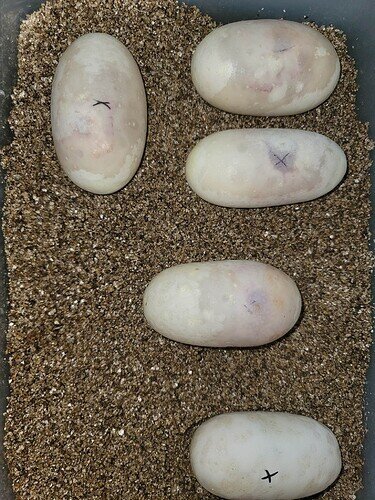One of my girls laid these eggs last night. 3 have very weak veins but visual embryos, one has better veins and embryo, and the last one looks perfect. The thing that worries me is she didn’t calcify the eggs properly. She eats consistently, She is on a back to back breeding year, I made sure her weight was good before pairing both times ( she’s earned a years vacation now) Just wondering if anyone else has dealt with this, is there a way to help the eggs? One of them seems to “Sweat” clear sticky liquid that I’ve dabbed off but I don’t want to disturb them.
Last year I had a girl lay some eggs that were porely calcified and they all hatched no problem. It seems it doesnt have too much effect on eggs that are safely in a controlled incubator. In the wild they may have issues not having that layer of protection.
Incubate until there’s no debate~
The sweating one is a bit of a concern, but good luck!
I work with corns, not BPs, but improperly calcified eggs can happen in any egg-laying species. Lack of calcification, irregular “stars” on the shells, even one or two with a window. It happens, and it can happen despite giving females proper calcium + vitamin D3 supplements. The odd looking eggs usually go right on and develop just fine.
Sometimes, when one has a very thin shell, it can be helpful to put in an area with a bit lower humidity humidity. I’m not sure what your setup is like, but if there’s a space in your area of incubation to set the sweating egg up where it’s a tad more dry, it may stop sweating. If it’s sweating from a specific spot, you might try placing a clean bit of wax paper on that area or unbleached paper. It shouldn’t hurt & may help stop the leak. If you have access to a bit of clean eggshell, such as if there was a definite slug in the clutch, you can place a bit of that shell on the leaky spot. It will almost always work to stop the leak.
That’s an awesome tip! I assume the only thing to watch for then if it was a large window area is to make sure they pip properly since part of the shell is much thicker with the slug shell on top?
If you have an eggshell from a previous clutch, wash it well, dry, cut to fit and use a thin line of pva (Elmer’s white) glue to cover the sweating area. Also good for tears.
Yep. I’ve always kept an extra watchful eye on unusual or “patched” eggs but so far, I haven’t seen issues with them pipping. I wondered last season if some world have trouble. Some of those shells which weren’t calcified as usual felt stiffer or thicker, but everybody hatched just fine.
That’s good to hear! I remember a breeder once saying that they had an situation where they left the eggs attached and the one baby pipped into another egg but looked like it may have drowned because of it.
Just another reason for me to cut if I’m going to be away when they’re due or separate the eggs from each other aside from mold concerns
I think I remember the comment you referenced about one pipping into a neighbor’s egg. Thankfully, I’ve never had that happen. I swear, if there’s anything that can go wrong its bound to happen sometime. My usual philosophy to try and keep my animals safe is, assume they actively want to kill themselves, then do everything I can to prevent them from succeeding. Some species are more skilled at self-harm than others. (Horses, for instance, notably, excel here.![]() )
)
Sheep… born looking for a way to die…
Turkeys, the babies need to be brooded with baby chickens so the chickens can teach them how to scratch and eat…
Goats, dumb enough to headbutt a truck, the truck that brings the haybales to their pasture…
Smh…![]()
Thanks everyone for the information! A couple of the weak veined ones look like theres more veins growing, but the one thats “sweating” is slowly turning that blue color that means its gonna go bad.
Sounds like most are going to be fine. Sorry that the one doesn’t look promising. Unfortunately that’s the way it goes sometimes. Hopefully the rest of the clutch will continue to develop and hatch just fine, despite their less than perfect calcification. ![]()
Im hoping. I always feel bad when theres something wrong with the eggs… not for monetary loss but just how hard the girls work to build amd lay the eggs
So do I! That’s very well said. I also hate when they lay second clutches. Those are mostly slugs here, since I don’t generally re-pair females. I would prefer they focused on rebuilding themselves after laying the first clutch.
